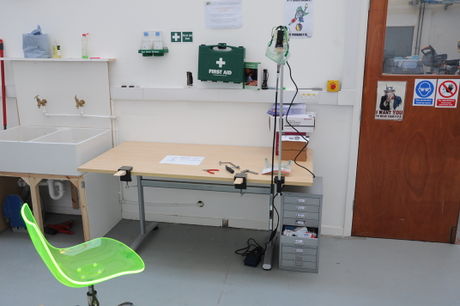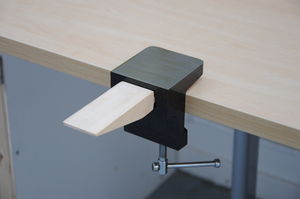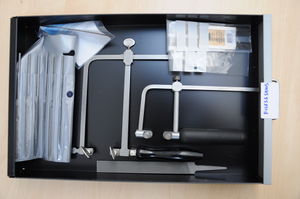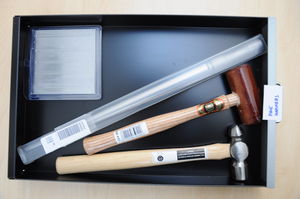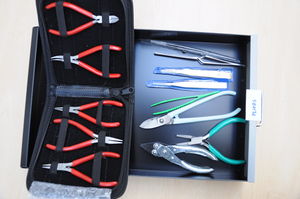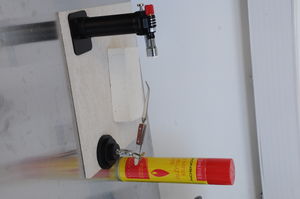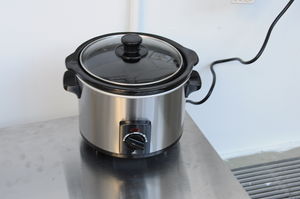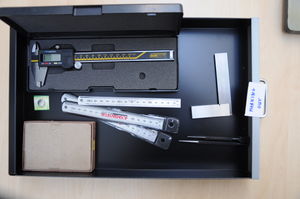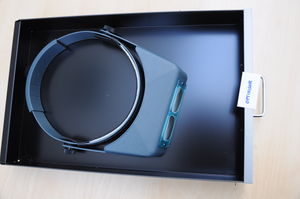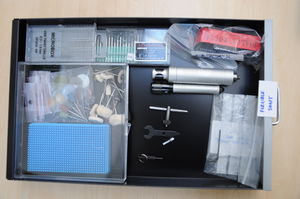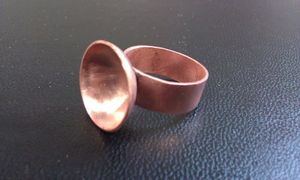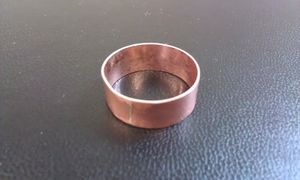Difference between revisions of "Equipment/Fine metalwork bench"
(→Avoiding Tool Damage) |
|||
| Line 33: | Line 33: | ||
== Avoiding Tool Damage == | == Avoiding Tool Damage == | ||
| − | It is vital to '''avoid contamination of the tools for fine metalworking''' (on silver, copper, or titanium) with particles of iron, steel, aluminium, or lead, otherwise pieces can be ruined when they are soldered. Accordingly, '''this bench and the fine metalworking tools must not be used on any materials except silver, copper, titanium, or gold''': especially not for steel, iron, aluminium, or lead. | + | It is vital to '''avoid contamination of the tools for fine metalworking''' (on silver, copper, or titanium) with particles of iron, steel, aluminium, or lead, otherwise pieces can be ruined when they are soldered. Accordingly, '''this bench and the fine metalworking tools must not be used on any materials except silver, copper, titanium, or gold''': especially not for steel, iron, aluminium, or lead. Some brass alloys are leaded; other brasses are ok. Wood and plastics are ok in moderation. |
Some of the tools have '''polished or machined surfaces that are easily damaged''', e.g. the planishing hammer, triblet, and bench block. These must not be used for hitting anything other than silver, copper, or titanium (especially, do not use the planishing hammer for hitting a punch, and take great care when hammering something on the triblet or bench block not to let the hammer come in contact with those). | Some of the tools have '''polished or machined surfaces that are easily damaged''', e.g. the planishing hammer, triblet, and bench block. These must not be used for hitting anything other than silver, copper, or titanium (especially, do not use the planishing hammer for hitting a punch, and take great care when hammering something on the triblet or bench block not to let the hammer come in contact with those). | ||
Revision as of 08:27, 9 May 2013
Class Red equipment: Do not use without specific training.
(More about equipment classes)
Contents
Summary
This is a bench and hand tools for fine non-ferrous metalwork, e.g. for silver jewelry-scale making. We also have a Flexible Shaft Drill at the same bench.
These are Category Red tools: induction is mandatory.
Using the fine metalwork bench
Owners
Trained
AH, HW, S.
Health and Safety
Formal Risk Assessment: Fine Metalwork Hand Tools and Silver Soldering
The gas torch and gas canisters (standard lighter gas) should be kept in the flammable stock cupboard in the workshop when not in use.
The gas torch should only be refilled in the open air, as there can be gas leakage in the process. It should only be used at the hot-working bench above the insulated sheet.
The pickle is a mild corrosive, and hot items should not be dropped directly into it or else there may be splashes that could cause eye damage. The pickle should not be warmed except in use.
Avoiding Tool Damage
It is vital to avoid contamination of the tools for fine metalworking (on silver, copper, or titanium) with particles of iron, steel, aluminium, or lead, otherwise pieces can be ruined when they are soldered. Accordingly, this bench and the fine metalworking tools must not be used on any materials except silver, copper, titanium, or gold: especially not for steel, iron, aluminium, or lead. Some brass alloys are leaded; other brasses are ok. Wood and plastics are ok in moderation.
Some of the tools have polished or machined surfaces that are easily damaged, e.g. the planishing hammer, triblet, and bench block. These must not be used for hitting anything other than silver, copper, or titanium (especially, do not use the planishing hammer for hitting a punch, and take great care when hammering something on the triblet or bench block not to let the hammer come in contact with those).
It's important not to contaminate one grade of abrasive with another: particles of coarse abrasive on a fine polishing wheel can scratch a piece heavily.
All the fine metalworking tools must be put away in the right place (the correct drawer of the grey filing cabinet, as labelled) after use.
Consumables and Stock (to pay by use)
We keep a small amount of silver and copper stock for people to get started with (copper behaves a lot like silver, so is good for practicing). If you use any of the following, please (a) write in the fine-metalworking stock book the thing and the amount you've used, your name, and the cost, and (b) put the cost in the MakeSpace cashbox. If we're close to running out, please let the owners know. The prices below are designed to just break even, not make a profit.
If you want to buy your own stock or tools, UK suppliers include Cookson [1], Sutton Tools [2] and HS Walsh [3]. It might well be worth clubbing together with other people to get volume discounts and share shipping. Copper and brass sheet can also be found at Mackay's in Cambridge [4].
- Saw blades: £0.30 each, per broken sawblade or if you want your own.
- Abrasive paper: £0.75 per sheet or £0.20 per quarter sheet
- Small drills: £1.00 per broken drill (the set of 20 Drills 0.3-1.6mm is around £14 + shipping)
- Copper sheet 24 SWG (0.56mm): £0.04 per square cm
- Copper sheet 20 SWG (0.91mm): £0.05 per square cm
- Sterling Silver Sheet 1.00mm: £1.00 per square cm (measuring the aligned bounding box) (cost is £46 for 75x75mm)
- Sterling Silver Sheet 0.50mm: £0.50 per square cm (measuring the aligned bounding box) (cost is £25 for 75x75mm)
- Sterling Silver Round Wire 1.00mm: £0.10 per cm (cost is £14.24 per 2m)
- Sterling Silver Round Wire 0.70mm: £0.05 per cm (cost £3.52 per 1m)
- Sterling Silver Round Wire 0.50mm: £0.03 per cm (cost £3.52 per 2m)
- Sterling Silver Square Wire 1.00mm: £0.10 per cm (cost £4.34 per 0.5m)
- Sterling Silver Hook Wire (NVK 023X): £1.30 per pair
- Sterling Silver Ear Pin, 11.1 X 0.8 (NVJ 102X): £0.10 each
- Sterling Silver Scrolls 110: £0.15 each
- Sterling Silver Round Snake Chain 18"/45cm 1.2mm (VVO R12H): £5.50
- Silver 1.6mm Snake Chain 18"/45cm (VV3 80H): £6.00
Other Consumables
- hard silver solder paste (£33.61 per tube, but a tube lasts a long time) [5]
- polish and polishing wheels (buy your own if making substantial use of these)
- Picklean Safe Pickling Powder (£6 for 150g)
- Diamond burrs (£4.80 for set of 30)
Tools
Workholding
- 2*Bench Peg And Anvil (these clamp on to a bench edge, to support work) [6]
Files and saws
- 6"/150mm Flat File, Cut 2 Vallorbe
- Set Of 12 Needle Files, 16cm - All Cut2 (one has to avoid contaminating silver with iron, so we'll want separate files for ferrous metals in addition to this)
- Grobet/vallorbe Saw Frame Adjustable [7]
- 6" Deep Adjustable Saw Frame [8];
- Vallorbe Saw Blades Grade 2/0, Bundle Of 12*12 (£30.82); Vallorbe Saw Blades Grade 6/0, Bundle Of 12 (£3.70) (those saw blades are consumables - they break easily)
- Straight 7"/17.5cm Shears (£12.54) (for brutal cutting of sheet metal. It's usually preferable to use a saw instead, to leave a square edge without bending the metal)
Hammering
- Flat Stake (this is a small anvil with a machined-smooth surface on all sides) [9]
- Round triblet (for forming rings and suchlike) [10]
- Planishing Hammer (a polished-surface hammer for surface finishing and work-hardening) [11] (on back-order)
- Rawhide mallet [12] (for hitting things without marking the surface)
- Generic ball-pean hammer (a non-polished hammer for hitting punches etc.)
Pliers and tweezers
- Cookson 5 Piece,115mm Pliers Set (box-jointed with smooth jaws)
- Ring Bending Pliers, Cookson Value Range
- 5.5"/ 140mm Maun Flat Pliers Parallel Action [13]
- Tweezer set [14] (brass and plastic tweezers for pickle, reverse and third-hand tweezers for soldering, fine tweezers for manipulating tiny things)
Soldering
- Hand Torch [15] (for soldering or annealing small pieces, up to 10-20mm. We also have a larger torch with the glassworking kit)
- Magnesia Soldering Block [16]
- Soldering Sheet 300mm X 300mm X 9mm [17]
- Picklean Safe Pickling Powder 150g [18]
- crock pot for keeping pickle warm
- hard silver solder paste (£33.61) [19] (consumable) (this is great for small-scale work; for bigger things one wants strip solder and flux)
Marking out
- 150mm Ruler * 3 [20]
- Standard Steel Scriber [21]
- centre punch [22]
- digital calipers [23]
- 3" square [24]
Magnification
- Optivisor 2.0x No5 (NB: this is *not* eye protection)
Flexible shaft drill tools
- Polishing Kit No 2 [25]
- Set Of 20 Drills 0.3-1.6mm (£15.96) (consumable) [26]
- diamond burrs (set of 30) (4.80) (consumable) [27]
To do
- get one or two adjustable desk lamps, perhaps with magnifier
- get another file, either another 6"/150mm Flat File, Cut 2 Vallorbe or a similar half-round
- get a joint cutter, either [28] £58 from cookson or a cheap one [29] £15 from Sutton Tools.
- get some dividers
- raise the bench somewhat and fix to the wall
Gallery
Please do add pictures of anything made using the fine metalwork tools. Here are some practice pieces from training (2013-05-12, AH, HW, S.):
How To
Jeweller's Saws
These should only be used on silver, copper, or titanium, *not on steel, iron, lead, or aluminium*, otherwise silver pieces may be permanently damaged by contamination when they are soldered.
Jeweller's saws have a thin flexible blade held under tension by a saw frame.
The blades come in different grades, from 4 (the coarsest) to 8/0 (the finest). In general one wants a coarse blade for cutting thick metal and a fine blade for cutting thin metal, and for tight curves. Fine blades are also more fragile.
- Grade 2/0 is a normal (medium) blade, with thickness 0.26mm, width 0.52mm, and 22 teeth per cm. The drill size for piercing is 0.55mm. These are ok for cutting metal from 0.5 to 1.0mm thick.
- Grade 6/0 is a rather fine blade, with thickness 0.18mm, width 0.35mm, and 32 teeth per cm. The drill size for piercing is 0.4mm. These are ok for cutting metal from 0.3mm to 0.5mm thick.
The saw frames have adjustable length. To fit a blade, loosen the knob that fixes the length and shorten the saw to be just shorter than a blade. Loosen the knobs at the ends that grip the blade, remove any broken blade fragments (and throw them away properly), insert the blade ends, and tighten the knobs (just finger-tight - you can strip the threads if you use too much force). The blade should be oriented with the teeth pointing towards the handle - if you run your finger (gently!) along the blade away from the handle, it should catch. Then tension the frame so that the blade rings a little when plucked, and tighten the associated knob - again, just finger-tight.
To use the saw, first arrange the workpiece (with your cutting line marked) so that it is supported very close (within a couple of mm) to the cut, and so that you can hold it down firmly (so it doesn't vibrate). Usually you can put it on the edge or end of a bench peg. Then arrange your chair so that your dominant hand and arm are in a vertical plane, with your forearm perpendicular to the bench. The saw cuts away from you, and usually one controls the direction of cutting by moving the workpiece rather than moving yourself. Hold the saw lightly with the blade vertical, and cut with an up-and-down motion. To get a cut started, sometimes it's helpful to take a short stroke upwards, keeping the blade in the right place with a finger next to it or behind it. Now cut! Keep the saw vertical, and remember that it cuts on the down-stroke. You shouldn't need to push very hard at all, either down or forwards.
If you need to cut around a sharp corner, remember to keep cutting, otherwise the blade will break. And don't twist the saw sideways in the cut, otherwise the blade will break. And if it jams, unjam it gently, otherwise the blade will break.
To start a cut in the middle of a sheet, you need to drill a clearance hold at least as big as the size above, depending which grade blade you're using. Then thread the blade through the piece when fitting it.
Jeweller's Files
These should only be used on silver, copper, or titanium, *not on steel, iron, lead, or aluminium*, otherwise silver pieces may be permanently damaged by contamination when they are soldered.
There are needle files (cut 2) and a 6"/150mm Vallorbe Flat File, also Cut 2. Files come in different finenesses; cut 2 is a medium general-purpose grade.
Remember: files cut on the push stroke.
It's often useful to put the flat file on the bench, hold it in place, and move a workpiece along the file (the file cuts when the workpiece is moved towards the tang), especially when filing a straight or gentle curve saw-cut smooth. Because of this, it doesn't have a handle - but that does mean that when filing free-hand, one must be careful not to push the tang of the file into the palm of your hand, if the file suddenly becomes stuck on something.
Filing the edge of a piece of sheet square will usually leave a tiny burr of metal along each corner of the edge, which should be removed with the file or with abrasive paper.
To make a rounded edge or corner, it's often best to first file off a small flat at 45 degrees (so one can easily control the size of the flat) and then smooth off.
Abrasive Papers
These should only be used on silver, copper, or titanium, *not on steel, iron, lead, or aluminium*, otherwise silver pieces may be permanently damaged by contamination when they are soldered.
Abrasive paper comes in grades from 200 (very coarse) through to 1500 (very fine). To smooth a surface or edge, one usually wants to start from (say) grade 600 and then work down through successively finer grades. It's usually good to cuts in a particular direction for one grade, then at 90 degrees to that with the next grade until all the scratches from the preceding grade are gone. It's often useful to support the abrasive paper on the bench, moving the workpiece against it, or wrap it around a piece of wood or scrap metal.
Soldering
TODO
Making Jump Rings
TODO
Planishing
TODO
Using the Ring Mandrel
TODO
